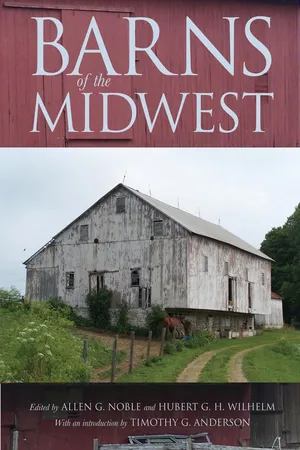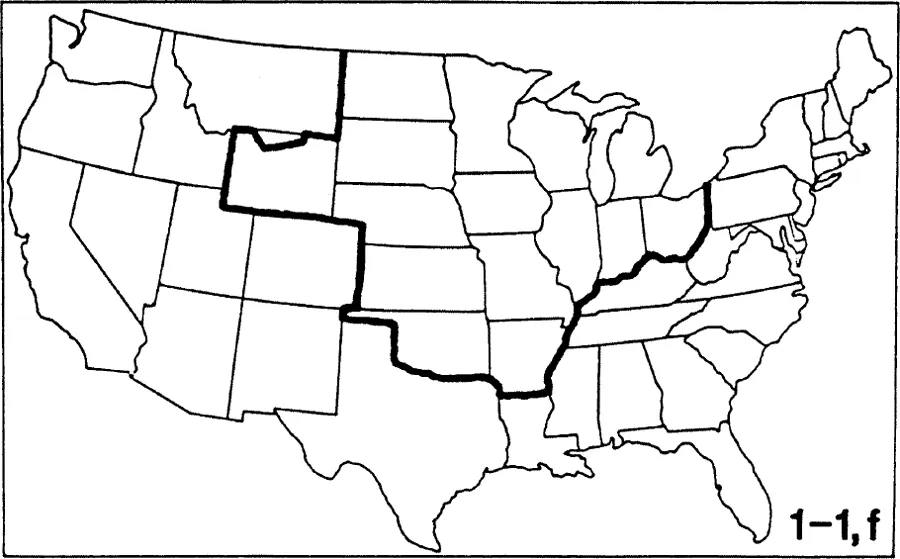![]()
1
THE FARM BARNS OF THE AMERICAN MIDWEST
Allen G. Noble and Hubert G.H. Wilhelm
FEW OBJECTS ARE as visible or striking as the midwestern barn. Indeed, for many of us, the barn is the symbol of the Midwest. It conveys stability, hard work, stewardship, solid citizenship and “rural values”—never mind the stereotypes or our stereotypical ideals.
The barn stores a series of traditions, and not just those brought into middle America by conservative English and German farmers from the east. Settlement in the Midwest, although primarily of Anglo-Saxon origins, was never homogeneous. So, there never has been a midwestern barn. The barn of the Midwest was—and is—many barns common enough to be recognizable as midwestern. Of course, even the term Midwest has many definitions and interpretations.
DEFINING THE MIDWEST
Everyone knows there is a Midwest, but few can agree on its precise boundaries. Geographers have been among the leaders in attempting to identify the limits of the Midwest (fig. 1.1), but even they do not agree. Much of the reason for such lack of accord is that the Midwest is a concept that can be approached from a number of equally valid viewpoints.
Charles B. Hunt (1974), a geologist, did not examine the Midwest per se, but he did define three physiographic areas which make up the interior of the United States: the Central Lowland, the Interior Low Plateaus, and the Great Plains (fig. 1.1a). His orientation was entirely toward physical conditions, but, taken together, those physical areas make up a unified interior region. Each of these physiographic units has its own particular character, but all share certain traits, providing an underlying physical unity. All possess an interior, continental location and, partly as a result of this, have a stronger inward than outward focus. Such a focus is also partly the result of general homogeneity of land-form surface. No lofty mountain ranges or extensive hill lands interrupt the generally smooth to rolling plains. Of course, some areas are hillier than others; the Flint Hills of Kansas, the Driftless Area of Wisconsin, the Salem Plateau of Missouri, southern Indiana, southeastern Ohio, and the Pennyroyal of Kentucky are certainly areas of dissected surface. It may be significant that virtually all of these areas lie on the margins of the Midwest. They also share a history of nonglaciation. Throughout most of the rest of the Midwest recent glaciation has provided a mantle of soils that helps sustain surplus agricultural production.
Fig. 1.1. Maps giving various boundaries of the Midwest
Geographers J. Wreford Watson and Stephen Birdsall and John Florin approached the Midwest from this agricultural perspective. Watson (1967) identified an agricultural Midwest region which extends eastward to include all of West Virginia, an extension which would seem difficult to defend (fig. 1.1b). Equally problematic is the northeastern boundary which roughly bifurcates Wisconsin, Indiana, and Ohio. Watson’s western boundary appears to be more logical in dividing the Great Plains, roughly excluding areas of irrigated cultivation, but including the extensive, dry grain farming areas of the Plains.
Birdsall and Florin (1981) identified an agricultural core region (fig. 1.1c). Its boundaries were rather restricted on the north, west, and south, but extended eastward to include northwestern Pennsylvania and the extreme western edge of New York. Although Birdsall and Florin admitted that the term “Middle West (or Midwest) will probably continue to be the most widely used and understood name for the U.S. portion of the continent’s agricultural core region,” they hesitated to use the term itself (271). Instead they invented the term Deep North, which is meaningless and confusing to virtually everyone except the authors. They rather weakly defended their term by noting that “‘Deep North’ refers to an area of particular cultural intensity and pervasiveness, but it does not refer to an area that is farther north than other places (271).
Westward of the agricultural core region is another region of primarily agricultural activity which Birdsall and Florin (1981) labeled The Great Plains and prairies (297–323). This area is differentiated from the agricultural core essentially because of its more extensive agricultural systems, lower productivity per acre, sparser water resources, and lesser urbanization and manufacturing emphasis.
Alfred J. Wright (1948), an economic geographer, acknowledged the Middle West to be “indefinitely defined.” He recognized that it was perhaps the premier American economic region, but he added that it had “achieved a regional character which transcends the economy and involves the cultural and political attitude of the people” (239). Wright extended his boundaries of the Middle West to include portions of the eastern Great Plains (fig. 1.1d). Although sketched out almost a half century ago, Wright’s limits of a midwestern region are surprisingly appropriate today, a tribute to his careful scholarship and perception.
The concept of the Middle West has been examined by both Wilbur Zelinsky (1980) and James Shortridge (1985) from the standpoint of the vernacular, a people’s everyday perception and usage. Zelinsky’s vernacular Middle West, relying on the use of the region’s name in local city directories, consists of two parts: a core extending from eastern Ohio to central Kansas and from central Wisconsin to southern Missouri; and a periphery of small extensions—East to include Pittsburgh, South to incorporate western Kentucky and northern Arkansas, and West, and North, Montana, Wyoming and eastern Colorado (fig. 1.1e).
Shortridge (1985), basing his definition on respondents’ perceptions, primarily agrees with Zelinsky’s vernacular Middle West but includes all of Arkansas and most of Wyoming, and leaves out the high plains states (fig. 1.1f).
Finally, Zelinsky (1992), in another study, defines the Midwest from the perspective of cultural evolution, from the meshing of migration streams from the New England, the Middle Atlantic, and, possibly, Chesapeake Bay “hearth” areas. From extreme western New York and Pennsylvania, the region fans out westward as far as the central Dakotas, Nebraska, and Kansas (fig. 1.1g).
Considering all these delineations of the “Middle West,” the veracity of Zelinsky’s statement that, “Everyone within or without the Middle West knows of its existence, but no one seems sure where it begins or ends,” is evident (1992, 128). In point of fact, some agreement does exist. Beginning in the vicinity of the Pennsylvania panhandle, the eastern boundary of the consensus Midwest excludes southeastern Ohio, but includes northern Kentucky. Farther west, southern Missouri and southeastern Oklahoma are excluded.
Also outside the designation of Midwest is the northern half of Minnesota and Wisconsin, which lies on the sterile Canadian Shield, and the northern half of Michigan, an area of boreal forest also with little agriculture. Within these areas the landscape has a distinctive logged-over appearance that has little in common with the Midwest. Furthermore, the economy here is based upon extractive industries and tourism, and the settlement groups differ culturally from those further south.
The western boundary of the Midwest enjoys no such unanimity of definition. Some authors extend the region entirely across the Great Plains to the foothills of the Rocky Mountains, a convenient and easily defined physical boundary. Others prefer to use the eastern boundary of the Great Plains as a limit. For the purposes of this study, we have chosen a western boundary roughly through the middle of the Great Plains (fig. 1.2). Such a boundary effectively divides the cultivated Great Plains from those areas in which livestock grazing is the predominant agricultural activity.
DEFINING THE BARN
Grazing activities normally do not require an investment in barns, other than those used as machinery sheds or for equipment storage. Crop agriculture, on the other hand, normally has a barn as its central focus. The same is also true of agriculture in which the focus is primarily upon dairying or animal raising aside from grazing. Thus, across the various farming areas of the Midwest, the barn, or a main structure with similar function, dominates each farmstead.
August Meitzen (1882), a well-known nineteenth-century German settlement geographer, wrote that “the house is the embodiment of a people’s soul” (Das Haus ist die Verkoerperung des Volksgeisies) (3). One can hardly argue with this observation of rural, vernacular, or folk houses. But, if the house reflects the soul of its owners, what about the barn? Although often structurally integrated with the house in Europe, the barn nevertheless represented a different image, one of work, surpluses, income, thrift, and risk-taking. To rephrase Meitzen, the barn then is the embodiment of a people’s economic worth. It is, to use Calkins and Perkins’ analogy from chapter 3, the “farmer’s bank.” In America, and especially so in the Midwest with its specialized, commercial agriculture, that image and function translated into extraordinary architectural forms, often appearing like veritable castles upon the rural landscape.
Fig. 1.2. The Midwest region
The word barn is defined in Webster’s as “a building for storing farm produce and/or stabling livestock.” Its origins in England refer more to the first function. The word is derived from a combination of two Anglo-Saxon words, here, meaning barley (or subsequently any grain), and ern, meaning place of storage. “Cow house,” “stable,” or some other term, is used to signify those structures providing animal shelter, although in the relatively mild climate of Great Britain animals are frequently left in the open during the entire year.
However, in North America, because of the harsher winter climate, the barn quickly assumed the functions both of animal shelter and crop storage. This was especially true for the earliest, simple barns in New England and elsewhere along the eastern seaboard, and along the advancing frontier as settlement pushed westward into the continent’s interior. Under these conditions, yeoman farmers could afford only a single barn that did double duty. Even the simple three-bay barns, which had evolved in England primarily to permit storage and processing of grains, were adapted in North America by introducing animal stalls on one side of the central threshing floor.
The barn, then, is defined in the American Midwest by the functions it performs, either originally or currently. These functions include animal shelter, crop storage, crop processing, equipment storage, and machinery repair. The barn refers to the place on the farm where any, or several, of these activities regularly takes place. However, if the building is specialized in function, its designation may carry an adjective, such as “sheep” barn or “horse” barn. Similarly, in some instances a substitute term, such as smoke house, machine shed, or sheep fold, may be used for the specialized-function structure, especially if a larger multipurpose “barn” is also on the farm.
FARMSTEAD PATTERNS AND THE POSITIONING OF THE BARN
The pattern of farmsteads and the relationship of the barn to ...









